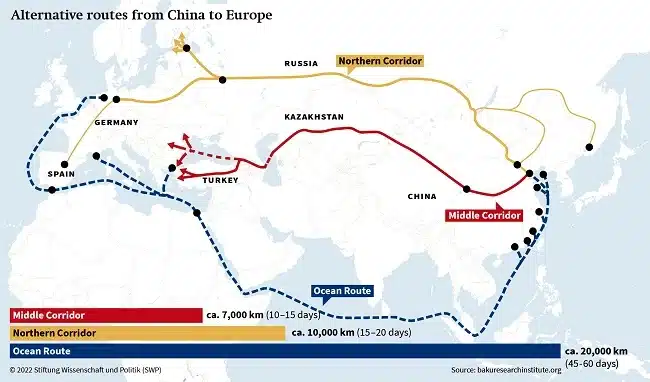The China-Turkey Belt and Road Cooperation is a testament to the power of strategic partnerships in shaping the global economic landscape. Emerging as a significant force in international trade and infrastructure development, the Belt and Road Initiative (BRI) launched by China in 2013 has found a steadfast ally in Turkey. This bilateral collaboration has opened new avenues for economic growth. It has improved connectivity and fostered cultural exchange between the two ancient civilizations. This article delves into the key aspects and implications of the burgeoning China-Turkey Belt and Road Cooperation.
The Belt and Road Initiative: A Brief Overview
The Belt and Road Initiative is an ambitious economic and infrastructural project initiated by China. It aims at enhancing global connectivity and fostering cooperation between nations. Comprising the Silk Road Economic Belt and the 21st Century Maritime Silk Road, this ambitious undertaking seeks to revive ancient trade routes and create modern linkages that facilitate seamless flow of goods, capital, and ideas.
Since its inception in 2013, the Belt and Road Initiative (BRI) has proven to be a powerful force in driving positive economic outcomes. Remarkably, it has generated 420,000 job opportunities. It has also uplifted nearly 40 million people out of poverty in countries outside of China. As per data from the World Bank, projections indicate that by 2030, Belt and Road cooperation will lead to a notable surge in trade for participating nations, ranging from 2.8 to 9.7 percent, and between 1.7 and 6.2 percent for the global economy. This surge is expected to bolster global real income, with anticipated growth rates ranging from 0.7 to 2.9 percent.
Turkey’s Strategic Position: A Gateway to Europe and Beyond
Situated at the crossroads of Asia, Europe, and the Middle East, Turkey plays a crucial role in the Belt and Road Initiative. With a rich history of trade and cultural exchange, Turkey is uniquely positioned to serve as a crucial transit hub, connecting the East and the West. Its strategic location offers significant opportunities for China to access European markets efficiently, while Turkey benefits from enhanced infrastructure and trade prospects.
China-Turkey Belt and Road Cooperation Projects
Alignment of Middle Corridor Initiative and BRI
Turkey stands as an early pioneer in the Belt and Road Initiative (BRI). In November 2015 during the G-20 Leaders Summit in Antalya, Turkey and China signed a “Memorandum of Understanding on Aligning the Belt and Road Initiative and the Middle Corridor Initiative.” This historic moment solidified their commitment to collaboration.
This visionary move aligns seamlessly with Turkey’s Middle Corridor initiative, which seeks to revive the historic Silk Road, creating a natural synergy with China’s BRI, aimed at fostering connectivity between the East and West. Turkey’s steadfast support for the BRI rests on the principle of mutual benefit, emphasizing a “win-win” approach.
Presently, an overwhelming majority of the approximately 10 million containers transported from China to Europe utilize sea routes, leaving a mere 4% to traverse the Trans-Siberian Railway, known as the Northern Corridor. However, the Middle Corridor offers a more economical and efficient trade route between Europe and Asia. By being 2,000 km shorter, enjoying more favorable climate conditions, and reducing travel time by one-third (15 days) compared to sea transport, the Middle Corridor has proven to be a game-changer. Additionally, this corridor opens up tremendous opportunities for cargo traffic in Asia, enabling goods to reach the Middle East, North Africa, and the Mediterranean region, facilitated by Türkiye’s strategic port connections.
One of the noteworthy achievements of the China-Turkey Belt and Road cooperation is the Trans-Caspian China Railway Express Chang’an Train, which completed its journey from Xi’an, China to Prague, Czech Republic in 18 days, with a pivotal stop in Ankara, Türkiye. Utilizing the Middle Corridor and Türkiye’s robust transport infrastructure, including the BTK railway and the Marmaray Tunnel, this freight train service signifies the immense potential for increased trade in the future.
Other Major China-Turkey Belt and Road Cooperation
Apart from the Middle Corridor, various major projects exemplify the tangible outcomes of China-Turkey Belt and Road cooperation. The iconic Marmaray Tunnel connecting Europe and Asia beneath the Bosphorus Strait, the Istanbul New Airport, and numerous high-speed rail lines demonstrate the transformative impact of this partnership on infrastructure development and economic growth.
The involvement of President Recep Tayyip Erdoğan in the BRI has been significant, with visits to China in May 2017 and July 2019 to further strengthen ties. This cooperation has also led to a substantial surge in direct foreign capital flow from China to Turkey, signaling the mutual benefits of the BRI.
Challenges to China-Turkey Belt and Road Initiative
Nestled along the ancient Silk Road, the Uyghur autonomous region plays a crucial role as a strategic gateway to the West within BRI. With their roots in Turkish heritage and strong Islamic beliefs, the Uyghur people stand apart from China’s dominant Han ethnic group. In recent times, China has faced mounting allegations of suppressing the Uyghur population. These events drew international attention, and Turkish people have also expressed their concerns regularly. Despite viewing the Uyghur issue as a domestic matter, Turkey’s cultural affinity and shared religious identity with the Uyghurs evokes a sense of compassion and solidarity. As a result, Turkey’s stance on this matter holds considerable weight in the larger context of China-Turkey relations and the prospects of the BRI.
Resolving the Uyghur problem is not only imperative for fostering robust China-Turkey relations but also holds the key to unlocking the full potential of investments under the vast scope of the BRI.
Conclusion
In conclusion, The China-Turkey Belt and Road Cooperation exemplifies the potential of international partnerships in creating a more interconnected and prosperous multi-polar world. By leveraging each other’s strengths and forging ahead with mutual respect, China and Turkey are paving the way for a brighter and more interconnected future for their citizens and the global community. As the collaboration continues to grow, both countries must remain committed to sustainable development, cultural understanding, and equitable trade practices.
FAQs:
Is Turkey a member of BRI?
Turkey is an active member of BRI. Turkey and China signed an MoU in 2015 in this regard.








